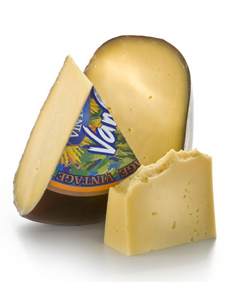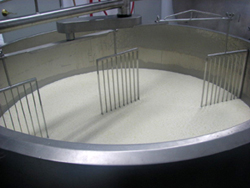

This Gouda-style cheese, called Van Gogh in hommage to the great Dutch artist, is made in Wisconsin by Emmi Roth Käse. Photo courtesy Roth Käse.
|
STEPHANIE ZONIS, Contributing Editor, focuses on good foods and the people who produce them.
|
|
February 2008
Last Updated March 2012
|
 |
The Case for Gouda Cheese
Page 2: How Gouda Is Made
This is Page 2 of a six-page article about Gouda. Here, how Gouda is made. Click on the black links to visit other pages.
How Gouda Is Made
Gouda, a washed-curd cheese, is always made from whole milk (while close relative Edam is made from partly-skimmed milk). With a minimum butterfat content of 48%, we’re not talking a caloric lightweight here.‡ It is semi-hard, with a creamy yellow paste that may or may not contain tiny holes (air bubbles created during the production process).
‡Volendam, is a young (aged 60 days), creamy Gouda named for a scenic Dutch fishing village, has a butterfat content of 55%.
During the manufacturing process, when the curd has been cut and is separated from the whey, a portion of the whey is drained off. Hot water is added to encourage the release of more whey from the curds. This is considered a “washing” of the curds. Washing the curd removes some of the lactic acid, which creates a sweeter cheese.
- When the curds have been sufficiently drained of whey, they are scooped into drainable molds, pressed to expel more whey, and eventually, released from the molds. Upon this release, the rounds of Gouda are placed into a tank of brine to promote rind formation and provide flavor to the cheese.
|
|

Curds and whey at Holland’s Family Farm, prior to draining and pressing into molds. |
- After some hours there (Holland’s Family Farm tells me that their big wheels spend 60 hours in the brine bath), they’re removed, dried off, and covered with a protective coating that inhibits mold growth. The cheese wheels are then placed on shelves (some creameries still use wooden shelves, but most use more modern materials) and turned periodically until the protective coating is dry.
- What happens next depends upon what fate the manufacturer intends for its Gouda. If the cheese is to be consumed young, it’s often dipped in red or yellow wax at this point, and left in cold storage for two or three months. This is a trickier business than it would seem, as the exterior of the cheese cannot be too wet or too dry when the cheeses are waxed.
An aged Gouda is a different matter altogether, as we’ll see in the next section.
Continue To Page 3: The Flavors Of Gouda
Go To The Article Index Above
CONTINUE TO PART 2:
- Food & Beverage Pairings
- Thirteen Goudas Tasted
- Have A Gouda Tasting Party
|
Lifestyle Direct, Inc. All rights reserved. Images are the copyright of their respective owners.

|





